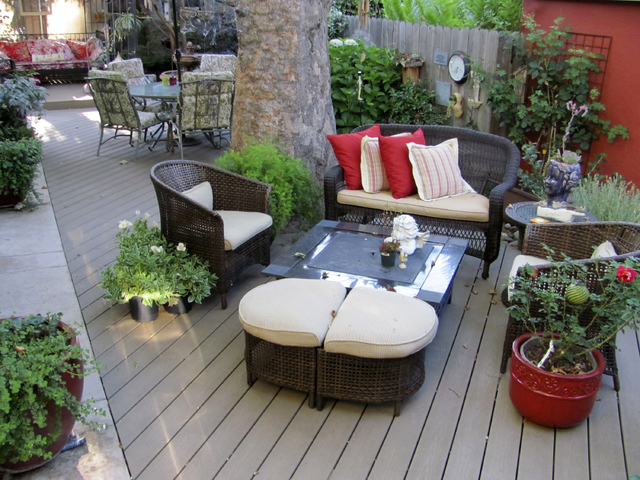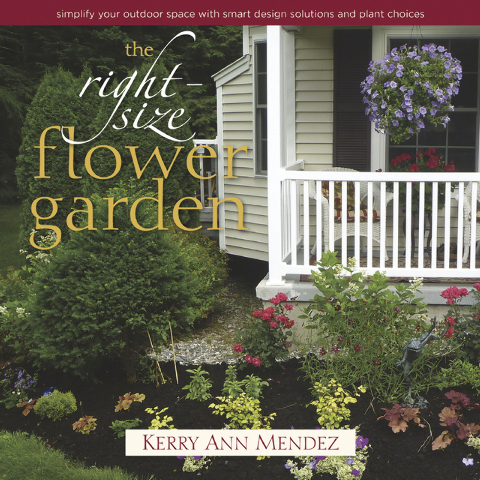Right-size your garden for ease of care
Kerry Ann Mendez speaks from experience as a recovering plant-aholic.
An accomplished author and garden designer, Mendez rationalized that she had to have all these plants for her work, but her garden went way beyond testing new varieties.
Whenever she discovered another irresistible perennial, she would add it to her burgeoning collection. It didn’t matter if there wasn’t room; she’d find a way to squeeze it in.
“We can’t help ourselves,” Mendez said in a phone interview, about others like herself. “We see beautiful plants, and we can’t resist. It’s insane.”
Eventually, she’s the one who got squeezed. Her garden overwhelmed her. It swallowed up all her time in big green chunks. She couldn’t keep pace with its ever-growing demands. Finally, a family crisis forced her to change. Some plants had to go.
“I just didn’t have the time or energy to keep it all going,” Mendez said. “It wasn’t fun anymore.”
Just like decluttering the house, the garden may need decluttering, too. The right plants in the right place in the right-size garden can cut down on maintenance, costs and water use.
It’s the right idea at the right time for boomers and others who still love to garden — or spend time outdoors — but don’t have the time (or healthy backs) to keep up their former hectic pace.
Mendez recorded her experience, with plenty of suggestions for other gardeners, in her new book, “The Right-Size Flower Garden” (St. Lynn’s Press, $18.95).
“I approach it like decluttering indoors,” Mendez said. “You don’t have to keep every plant. We have the freedom to get rid of poor performers or ones that give us more angst than joy. As gardeners, we’re inherently nourishers. And that’s why we don’t want to give up on any plant. It’s hard to let go.
“But these aren’t your children, they’re not your pets — they’re plants,” she added. “It’s OK to dig some up and say goodbye. We have the freedom to change.”
Mendez hopes other gardeners don’t have to face traumatic situations like hers before they decide to make that change. Her husband, Sergio, broke his neck. Fortunately, he wasn’t paralyzed, but he was forced to retire. Suddenly, Kerry needed to be both caregiver and family breadwinner. There was no time to garden.
“I lost my passion,” she recalled. “The garden had become another chore.”
Eventually, the couple decided they needed to downsize.
“Or as I prefer to call it, we right-sized our lives,” she recalled.
Her garden also overwhelmed potential homebuyers; nobody wanted to commit to a garden that was jampacked with unusual plants. They looked like too much work.
Systematically, Kerry Mendez pulled out perennials and plugged in alternatives that offered a lot of showy impact with little or no maintenance.
“My goal was to reduce overall maintenance by 50 percent without compromising beauty,” she said. “I did that and then some.”
The big house sold and the couple moved into a condominium with their teenage son. She now maintains a much smaller, but still color-packed garden. And Mendez had the makings of another book.
“I have my time back,” she said. “To me, right-sizing is freedom regained. And I love gardening again because it’s manageable.”
Her insights and advice ring true with other experts. Her right-size approach has another big upside: less water use.
“People are looking for resources; they want help now,” said landscape designer Cheryl Buckwalter, executive director of EcoLandscape California. “I could spend all day every day just answering questions.”
Many water-wise plants also need less care, she noted. That helps solve two issues at once.
“It’s time to make choices,” Buckwalter said. “People need to make these choices before they experience a life-changing event. So, as we age, we’ve already adjusted. It’s a better way. We’re not tied to a labor-intensive landscape.
“I find it exciting,” she added. “Make sound plant choices; put the right plants in the right place. And it makes it easier to care for them, too.”
Drought really has sped up the right-size evolution in California gardens.
“Absolutely, everybody is concerned about this,” said Orangevale, Calif., landscape designer Susan Silva. “But it’s not just drought, but maintenance. A large majority of my customers are baby boomers. They want to retire in their current homes with ease of outside maintenance and low-water plants in their yards.
“Sometimes, people view their garden as exercise and they like the workout,” she added, “but most people — especially as they age — want something that needs less work. Or they’ve down-sized their home, and they’re ready to down-size their garden, too.
“It makes complete sense to properly plan your landscape now for the long term with the right kinds of plants and well-selected hardscape for the space,” Silva said. “Whether it’s a small yard, a large yard, or anywhere in between, the maintenance and water usage can be low if planned well.”
The first target often is the lawn — “the highest maintenance thing in most people’s yard,” Mendez said.
“Lawns require so much work and so much water,” Silva said. “Just about everything else takes less water than lawn. When you take out the lawn, you have a nice amount of space to do something much more creative while still saving water.”
Key to making these makeovers work is plant choice. Mendez swears by flowering shrubs or evergreens with brightly colored foliage. They offer high-impact interest, often year-round.
“Shrubs take up a lot of space without much work or water,” she said. “One midsize shrub can take the space of 10 perennials with one-tenth the work, while still making a big impact visually. In the right-size garden, less really can be more.”
DESIGN FOR GARDEN SAFETY
Besides maintenance, safety is an issue for older gardeners. Raised beds — tall enough so stooping is kept at a minimum — help aging backs. Level paths help eliminate falling risks.
When Joyce Mills purchased her Sacramento home in 2005, it still had its original yard, circa 1928. Dominated by a gigantic sycamore, the patio had been turned into an uneven sea of massive tree roots and broken pavers.
“There were just way too many elevations to go up and down and places to trip,” she recalled. “I needed to get something safer.”
Mills connected with Silva to transform her backyard obstacle course. A wrap-around deck takes the place of the patio, affording the roots room to breathe and protection from being crushed by concrete or heavy traffic. Container plants change with the season.
In two phases, they transformed the old yard into an easy-care place for entertaining with nooks for relaxing and places Mills can enjoy her outdoor space without feeling risk.
Her garden — “big enough to still piddle around in,” she said — is now just the right size.


















